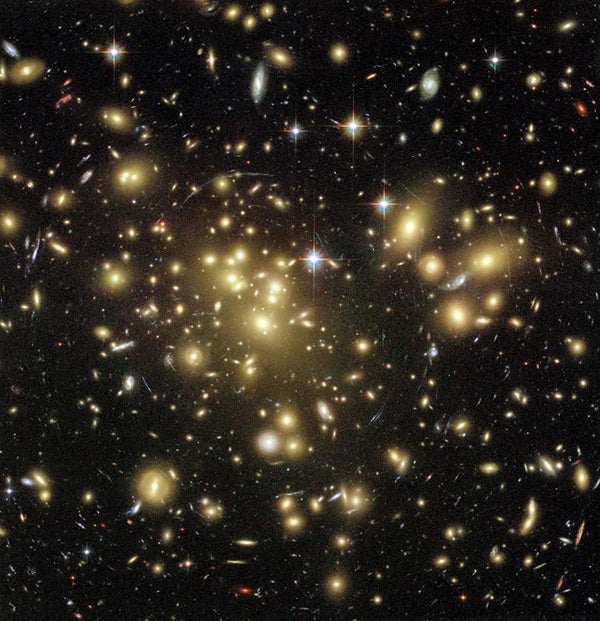In all cases, these images surround the object responsible for the lensing. So, if we think of the lensing galaxy as a sort of magnifying glass, why doesn’t the image appear superimposed? It’s as if we’re looking through a magnifying glass but seeing an image 3 feet to its side.
In fact, the image does appear inside the lens — it’s just that the lens is invisible. Light does not have to pass through a galaxy to be deflected by its gravity. Take, for example, the beautiful image of the galaxy cluster Abell 1689 captured by the Hubble Space Telescope. Gravity binds the cluster’s bright, yellow galaxies, and the density of galaxies traces the depth of the cluster’s gravity well, roughly telling us where the invisible gravitational field lies. (X-ray views, which reveal intensely heated gas within the cluster, provide another way to “see” the gravitational field.) Blue-white arcs among the yellow galaxies are lensed images of background objects seen within gravity’s lens.
Not every example of lensing in the cosmos is gravitational, of course. Just as light rays bend when they interact with the electrons in a piece of glass, so astron-omers can see — in X rays — objects lensed when their light interacts with electrons in the dust of a foreground galaxy. The resulting halos, analogous to Einstein rings produced by gravitational lensing, were first observed in 1983. Of course, if you can’t see the dust itself, then such halos would be — at first — as mysterious as those made by gravity. Bruce Draine and Nick Bond of Princeton have suggested using the geometric relations in the lensing of these halos to determine cosmological distance scales, something astronomers have been doing with gravitational lenses for some time.
Texts on gravitational lensing say the images produced are not true images in an optical sense: Their light is not focused to a point at the observer. But our telescopes have no problem gathering up the light and taking care of the focusing themselves. — SIMON DEDEO, PRINCETON UNIVERSITY










